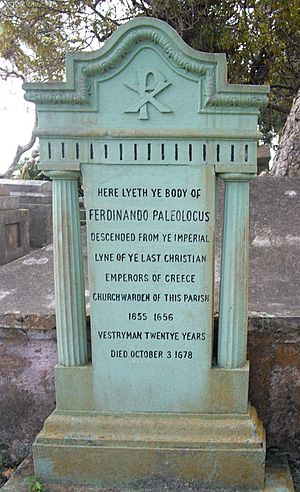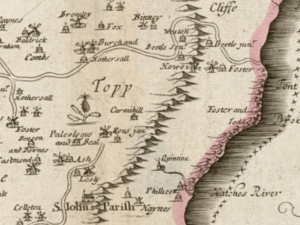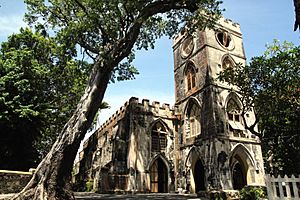Ferdinand Paleologus facts for kids
Quick facts for kids
Ferdinand Paleologus
|
|
|---|---|

Monument erected in 1906 near Ferdinand's grave in Saint John, Barbados. The date of Ferdinand's death presented on the monument, 3 October 1678, is erroneous
|
|
| Born | June 1619 Plymouth, Kingdom of England |
| Died | 2 October 1670 (aged 51) Colony of Barbados |
| Buried | Saint Johns Parish Church Cemetery Saint John, Barbados |
| Noble family | Paleologus |
| Spouse(s) | Rebecca Pomfrett |
| Issue | Theodore Paleologus |
| Father | Theodore Paleologus |
| Mother | Mary Balls |
| Occupation | Soldier, vestryman, churchwarden, owner of a cotton or sugar (and possibly pineapple) plantation |
Ferdinand Paleologus (Italian: Ferdinando Paleologo; June 1619 – 2 October 1670) was an interesting person from the 1600s. He was an English-Italian landowner and farmer in Barbados. He also helped lead his local church. Many people believe he was one of the last living members of the Palaiologos dynasty. This was a very old royal family that ruled the Byzantine Empire from 1259 until 1453.
Ferdinand was the youngest of four sons of Theodore Paleologus. Theodore was an Italian soldier who moved to England in the late 1500s. Ferdinand supported the king's side during the English Civil War (1642–1651). He moved to Barbados around that time. Perhaps he was escaping trouble, or maybe he wanted to find his fortune. His mother's relatives lived on the island.
Ferdinand arrived in Barbados by 1644. He quickly became part of the island's important families. He grew crops like cotton or sugar, and maybe even pineapples. He was very active in the St. John's Parish Church. He became a church leader, first as a vestryman and then a churchwarden.
Ferdinand built a large and grand house called Clifton Hall. He named it after his family's home in Cornwall, England. Even today, Clifton Hall is one of the biggest and oldest great houses on Barbados. By the time he died in 1670, people on the island knew him as the "Greek prince from Cornwall." This nickname stuck for centuries. His grave marker at St. John's Parish Church is a popular spot for visitors. It was put up in 1906, but it wrongly says he died in 1678 instead of 1670.
Contents
Ferdinand's Early Life
Birth and Family
Ferdinand Paleologus was born in June 1619. He was the fourth son of Theodore Paleologus and his wife, Mary Balls. He was baptized in Plymouth, England, on June 15, 1619. The church record called him "Ffardinando son of Theodore Paleologus an Ittalian." Most people called him Ferdinand Paleologus.
As Theodore's son, Ferdinand might have been one of the last people related to the Palaiologos dynasty. This family ruled the Byzantine Empire for almost 200 years. People at the time believed Ferdinand and his father were indeed from this royal family. Ferdinand had three older brothers and two older sisters.
Soldier and Move to Barbados
After his baptism, Ferdinand's name next appears in 1639. He was listed as a soldier at St Michael's Fort in Plymouth Sound. This shows that Ferdinand, at age 19, supported the king's side in the English Civil War. He was a common soldier, not a commander.
It's not clear what happened to Ferdinand right after 1639. He might have gone to Barbados to avoid problems in England. Or he might have moved there even before the war started. He likely went to find his fortune with his mother's relatives, the Balls family. They owned several large farms, called plantations, on Barbados. The Balls family and Ferdinand were among the first people to settle on the island. The British first settled Barbados in 1627.
Life on Barbados
Settling on the Island
Ferdinand was first officially recorded in Barbados on June 26, 1644. He and his older brother, John Theodore, were witnesses to a legal document. Ferdinand slowly became part of the important families on Barbados. Before 1649, he became a landowner, likely with help from the Balls family. He married Rebecca Pomfrett, whose father was also a local landowner.
Ferdinand built and owned a large estate called Clifton Hall. It was named after his family's old home in England. He also owned a farm that grew cotton or sugar. Clifton Hall is located near St. John's Parish Church. Ferdinand supported this church throughout his life.
Clifton Hall and Plantations
Clifton Hall is still standing today. It is known as one of the largest, grandest, and oldest great houses on Barbados. Most of the house today looks different from Ferdinand's time. Many parts were changed in the early 1800s. Only the kitchen and staff rooms, plus two small rooms, are original from the 1600s.

In 1649, Ferdinand was chosen to be a vestryman for St. John's parish. In those early years, vestrymen were powerful leaders on the island. Over time, he bought more land. A 1685 map of Barbados shows a farm called the "Paleologus and Beal" plantation. It has a drawing of a pineapple, which means Ferdinand might have grown pineapples. Like other plantation owners of that time, Ferdinand's plantation would have used enslaved people for labor.
Community Leader
By 1655, Ferdinand was a churchwarden, another important church role. In 1656 and 1660, he was a trustee. He also worked on other community matters. He was a lieutenant in 1654 and a surveyor of highways in 1660. He became well-known on the island as the "Greek prince from Cornwall." People remembered him by this nickname for a long time after he died.
Ferdinand's Death
Final Days
Ferdinand was absent from a church meeting in January 1670. This was probably because he was sick. His health got worse over the next few months. On September 26, 1670, he wrote his will. It began:
In the name of God, Amen. I Ferdinand Paleologus, of the parish of St John's, being sick in body, but in perfect memory, commit my soul into the hands of Almighty God, my most merciful Creator, and my body to be interred in a Christian burial, there to attend the joyful resurrection of the just to eternal life by Jesus Christ my most blessed Saviour and Redeemer.
In his will, Ferdinand left half of his property to his wife, Rebecca. The other half went to his son, Theodore. Theodore's share was for his "maintenance and education" until he turned fourteen. Ferdinand also left money to his sisters, Dorothy and Mary, and to a godson and a friend. The will was changed on October 2. This change said Rebecca would get everything if Theodore died before her without children. Important people on Barbados witnessed his will.
Burial Site
Many different dates have been given for Ferdinand's death over the years. This is mostly because the old documents are hard to read. His gravestone, put up in 1906, incorrectly says he died on October 3, 1678. It is most likely that he died on or soon after October 2, 1670. He was buried in the cemetery of St. John's Parish Church.
Ferdinand's Legacy
The Gravesite Discovery
On October 13, 1819, a hurricane hit Barbados. St. John's church was damaged. While moving bodies that had been disturbed, Ferdinand's body was found. A historian from the 1800s, Henry Bradfield, wrote about it. He said the body was in a large lead coffin. The feet were pointing to the east, which people thought was an old Greek custom. When the coffin was opened, a perfect skeleton was found. Everyone thought he must have been a very tall man. Local stories had always said the "Greek prince from Cornwall" was tall.
The lead coffin was opened again on May 3, 1844. This was to "test the truth of the tradition." Again, Ferdinand's skeleton was found to be very large. It was also covered in quicklime. This was sometimes used to help bodies break down faster, especially if there was a fear of disease. The idea that his feet pointed east because of a Greek custom is not true. It was actually a common way to bury people in England at that time.
A Tourist Spot
Today, Ferdinand's gravesite is used to attract visitors to Barbados. Travel brochures call the monument "one of the oldest on Barbados." Signs at St. John's church point directly to it. However, the monument itself is quite new, built in 1906. Ferdinand's body was moved in the 1900s. So, the monument marks his current burial spot, not where he was first buried in 1670. The words on the monument are similar to his father's tombstone in Cornwall. It reads:
Here lyeth ye body of Ferdinando Paleolocus, descended from ye Imperial lyne of ye last Christian Emperors of Greece
Churchwarden of this parish 1655 1656
Vestryman twentye years
Died October 3 1678



